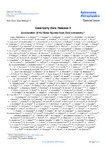Gaia Early Data Release 3: Acceleration of the Solar System from Gaia Astrometry

Use this link to cite
http://hdl.handle.net/2183/28475Collections
- Investigación (FIC) [1685]
Metadata
Show full item recordTitle
Gaia Early Data Release 3: Acceleration of the Solar System from Gaia AstrometryAuthor(s)
Date
2021Citation
S. A. Klioner, et al., «Gaia Early Data Release 3 - Acceleration of the Solar System from Gaia astrometry», A&A, vol. 649, p. A9, may 2021, doi: 10.1051/0004-6361/202039734
Abstract
[Abstract] Context. Gaia Early Data Release 3 (Gaia EDR3) provides accurate astrometry for about 1.6 million compact (QSO-like) extragalactic sources, 1.2 million of which have the best-quality five-parameter astrometric solutions.
Aims. The proper motions of QSO-like sources are used to reveal a systematic pattern due to the acceleration of the solar systembarycentre with respect to the rest frame of the Universe. Apart from being an important scientific result by itself, the acceleration measured in this way is a good quality indicator of the Gaia astrometric solution.
Methods. Theeffect of the acceleration was obtained as a part of the general expansion of the vector field of proper motions in vector spherical harmonics (VSH). Various versions of the VSH fit and various subsets of the sources were tried and compared to get the most consistent result and a realistic estimate of its uncertainty. Additional tests with the Gaia astrometric solution were used to get a better idea of the possible systematic errors in the estimate.
Results. Our best estimate of the acceleration based on Gaia EDR3 is (2.32 ± 0.16) × 10−10 m s−2 (or 7.33 ±0.51 km s−1 Myr−1) towards α = 269.1° ± 5.4°, δ = −31.6° ± 4.1°, corresponding to a proper motion amplitude of 5.05 ±0.35 μas yr−1. This is in good agreement with the acceleration expected from current models of the Galactic gravitational potential. We expect that future Gaia data releases will provide estimates of the acceleration with uncertainties substantially below 0.1 μas yr−1.
Keywords
Astrometry
Proper motions
Reference systems
Galaxy: kinematics and dynamics
Methods: data analysis
Proper motions
Reference systems
Galaxy: kinematics and dynamics
Methods: data analysis
Editor version
Rights
© ESO 2021





